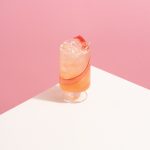BACKGROUND
James Bond 007 ordered his first Martini in Goldfinger written in 1964, but the following year he ordered a Pink Gin in ‘The Man with the Golden Gun.’ This type of pink gin was with Angostura bitters and not using the brands we now find on the supermarket shelves.
Pink gin has been a phenomenon with everyone trying to get into the market. It started back in 2013 with Pinkster and by 2020 it was a market for all!
Gin Foundry summed it up “It was as though Mr Blobby himself had exploded across the Gin hemisphere, filling bottle after bottle with weird, sweet, not-quite-gin flavours and bright, bold, dusky pink colours”.
If we’re getting technical, many of the spirits labelled as “pink gin” are probably vodkas or liqueurs, because due to the lack of strong juniper notes that make gin, well, gin.
GROWTH
The Wine and Spirits Trade Association reported that Flavoured Gin had driven half of all growth in Gin sales in the UK in 2018, coming from nowhere to represent one fifth of total Gin sales at the beginning of 2019. That number has increased in the year that has passed with many experts saying that flavoured gin is now one third of the category in the UK.
By 2020 there were over 200 pink gins in the UK market. Gordon’s Pink Gin sells well over 15 million bottles a year now and is growing at a considerably faster rate than its flagship dry.
It seems that every distillery is in on the act, trying to create a pink gin. In doing so you would be forgiven for thinking that they are all the same and equal, but unfortunately, you'd be quite wrong.
In reality, there are varying standards and processes to produce gin, ranging from small, family-run, craft distilleries who produce small batches by hand, to larger corporates who have automated production lines making 100,000 litres at a time.
Gin Foundry estimate that at least half of all British brands have now put out a Fruit Infused Gin, no matter how seriously they would all like to be perceived as category-protecting artisans. They also wager that many of those infused Gins will be pink in colour and have a good dose of sugar to sweeten them.

To be pink distillers must add some form of colouring, as not many pink things come out of a still!
The industry uses the following techniques and methods to create pink gin.
FLAVOURING & COLOUR
Many brands use natural flavour essences. This allows them to ensure the flavour is identical between batches, with no variance or seasonality.
There are often teams of scientists working with these companies who combine multiple natural or artificial compounds to create the intended flavour. However, these flavours do not add colour, and these must be added providing the bright vivid hues that we often see on the supermarket shelves.
These artificial colours will not degrade in sun light or with time.
ADDING OTHER LIQUIDS
This is the least travelled route, as it requires a partnership with someone who can provide either wine or fruit juice of some type. The second non gin liquid is then added to the gin post distillation to bring it down to bottling strength.
Warner’s adds Rhubarb juice (34%) to every bottle providing an authentic flavour and colour. In 2017 they sold over 350,000 bottles of Rhubarb Gin.
Mirabeau Rose Gin has Rose Wine added to it, sourced from their own distillery, and Bloody Shiraz is also done in this same manner.
MACERATION
This is the most common way distillers create their products, using natural and fresh ingredients. Maceration is where the fruit sits within the gin post distillation. These natural fruit flavours can come from raspberries, strawberries, red currants, and rhubarb.
The alcohol extracts both the colour and flavour of the fruits. This method also means that the gin could have sediment or organic material within it if it is not filtered prior to bottling.






SUGAR CONTENT
Sugar is used to provide the sweetness for some of these pink gins. Warner’s Rhubarb Gin has 64g of sugar in a bottle whilst Beefeater have 32g in a bottle. Some of the other nation’s favourite flavoured gins contain up to 65g, the equivalent of 15 teaspoons, in a full bottle. The Daily Mail did an article back in 2019 (pre covid) showing the sugar content that most brands were using.
For those who like London Dry gins you will be glad to know they are not allowed to be artificially sweetened.

RASPBERRY GIN
- Place 250g of raspberries and 700ml of gin into a kilner jar.
- Store in a dry dark place and leave the mixture to steep for 2 weeks.
- Give it a gentle shake to help with the infusion.
- After 2 weeks, strain the gin through a muslin cloth into a bottle.
- Add a little sugar syrup to help sweeten to your tastes.
STRAWBERRY GIN
- Place 250g of raspberries and 700ml of gin into a kilner jar.
- Store in a dry dark place and leave the mixture to steep for 2 weeks.
- Give it a gentle shake to help with the infusion.
- After 2 weeks, strain the gin through a muslin cloth into a bottle.
- Add a little sugar syrup to help sweeten to your tastes.
FINAL WORD
Pink gins span a vast flavour profile spectrum, ranging from floral-driven to herbaceous to slightly sweet. These final flavours are highly dependent on the botanicals with which the dry gin has been macerated.
A word of warning, the sugar level in pink gin will mask the strength of the alcohol you have consumed. Please be aware they will change your perception of how much has been drunk.
Enjoy responsibly.




